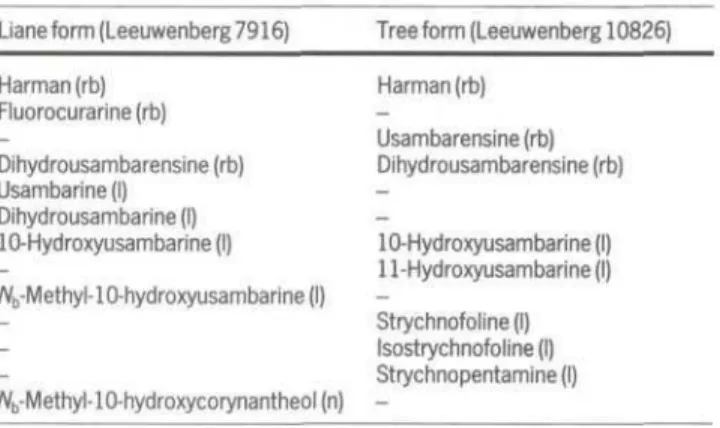Letters Planta Med. 57(1991) 501
Alkaloids of Strychnos
usambarensis Stem Bark
Joëlle Quetin-Leclercq', Monique Tits1, LucAngenot1-3,
and Norman G. Bisset2
1 Institut de Pharmacie, Université de Liège, rue Fusch 5, B-4000 Liège,
Belgium
2 Chelsea Department of Pharmacy, King's Collège London, University
of London, Manresa Road, London SW3 6LX, U.K.
3 Address for correspondance
Received: August 23,1990
Strychnos usambarensis Gilg
(Loga-niaceae) is one of thé three most widely distributed African species of Strychnos L. In East and South Africa thé plant grows as a small tree 3-15 m in height. In several other localities in East Africa, as well as in Zaïre, Congo, and West Africa, it is found as a climber up to 70 m long (1). The only other morphological différence between thé two forms is thé présence of tendrils in thé climbers.
The roots and leaves of thé arborescent form are thé main ingrédient of an arrow poison prepared by thé Banyambo hunters of Rwanda (2). In this case, thé curarizing activity of thé roots is mainly due to quaternary bases such as curarine, calebassine, dihydrotoxiferine, and afrocurarine, found in thé root bark along with numerous other bases like usambarensine and akagerine (3-6). The leaves from thé same plant hâve yielded 16 tertiary indole alkaloids (6, 7), mainly dimers possessing a usambarane skeleton substituted or not at C-10, C-ll, orC-12. Some of thèse asymmetric dimers, e. g. strychnopentamine, usam-barensine, and usambarine, etc., hâve pharmacological in-terest because of their antimitotic, amoebic, and anti-plasmodial properties (8, 9). A sample of leaves from thé Ivory Coast, belonging to thé climbing form of thé species, has yielded only C-10 substituted usambarane-type bases; C-ll or C-12 substituted alkaloids were absent (10).
The présent note reports on thé isolation and identification of thé alkaloids présent in two samples of stem bark collected in thé Ivory Coast (liane form) and in Tanzania (tree form) by Prof. F. Sandberg, Uppsala, Swe-den, and identified by Dr. A. J. M. Leeuwenberg, Wageningen, The Netherlands. Voucher spécimens (Leeuwenberg 7916 and 10826, respectively) hâve been de-posited in thé Herbarium of thé Agricultural University, Wageningen, The Netherlands (WAG). Both samples fur-nished less than 0.5 % total alkaloid extract. The major al-kaloidal components were identified by comparison (Co-TLC, UV, IR, MS) with authentic samples available in thé laboratory (11). The composition (Table 1) appears to be in-termediate between that of thé leaves and roots, and once again it was noted that C-ll and C-12 substituted alkaloids were absent from thé liane form. Thèse findings are of taxonomic interest, because they show that thé enzyme po-tential of thé two forms is différent, but whether thé biochemical distinction is paralleled in any way by a degree of morphological differentiation that might warrant thé
cre-Table 1 Alkaloid composition of thé stem bark of Strychnos usambarensis
Gilg.
Liane form (Leeuwenberg 7916) Tree form (Leeuwenberg 10826) Harman (rb) Fluorocurarine (rb) Dihydrousambarensine (rb) Usambarine (I) Dihydrousambarine (I) 10-Hydroxyusambarine (I) /Vb-Methyl-10-hydroxyusambarine(l) Harman (rb) Usambarensine (rb) Dihydrousambarensine (rb) 10-Hydroxyusambarine (I) 11-Hydroxyusambarine (I) /Vb-Methyl-10-hydroxycorynantheol(n) Strychnofoline (I) Isostrychnofoline (I) Strychnopentamine (I)
(rb) = Previously found in thé root bark; (I) = previously found in thé leaves; (n) = First found in thé course of thé présent work (12).
ation of appropriately named varieties is a point that re-quires further investigation.
Acknowledgements
We are grateful to Prof. F. Sandberg, Uppsala, for making available thé plant materials and to Dr. E. De Pauw for thé FAB mass spectra. One of us (J. Q.-L.) is a senior research assistant of thé Belgian National Fund for Scientiflc Research (FNRS).
Références
1 Leeuwenberg, A. J. M. (1969) The Loganiaceae of Africa VIII.
Strychnos III. Mededeel. Landbouwhogeschool Wageningen 69 (1),
267.
2 Angenot, L. (1971) Ann. Pharm. Franc. 29, 353.
3 Angenot, L., Bisset, N. G. (1971) J. Pharm. Belg. [n. s.] 26, 585. 4 Angenot, L., Dubois, M., Ginion, C., Van Dorsser, W., Dresse, A.
(1975) Arch. Internat. Pharmacodyn. Thérap. 215, 246.
5 Caprasse, M., Angenot, L., Tavernier, D., Anteunis, M. J. 0. (1984)
Planta Med. 50,131.
6 Massiot, G., Delaude, C. (1988) African Strychnos Alkaloids. In: The
Alkaloids. Chemistry and Pharmacology, (Brossi, A., éd.), Académie Press, London, Vol. 34, pp. 211-329.
7 Angenot, L., Coune, C., Tits, M. (1978) J. Pharm. Belg. [n. s.] 33, II. 8 Leclercq, J., De Pauw-Gillet, J., Bassleer, R., Angenot, L. (1986) J.
Ethnopharmacol. 15, 305.
9 Wright, C. W., Bray, D. M., O'Neill, M. J., Warhurst, D. C., Phillipson,
J. D., Quetin-Leclercq, J., Angenot, L. (1991) Planta Med. 57, 337.
10 Koch, M., Fellion, É., Plat, M. (1973) Ann. Pharm. Franc. 31,45. 11 Quetin-Leclercq, J. (1989) Thesis, Université de Liège.
